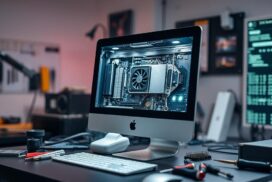What Does a Computer Repair Technician Actually Do?
Modern computer repair technicians keep technology running smoothly. They diagnose and fix both hardware and software issues, ensuring devices perform at their best. Whether in shops, offices, or homes, these experts tackle everything from faulty motherboards to system crashes.
Their work involves hands-on repairs, troubleshooting, and guiding users on preventive care. With an 11% job growth projected, this career offers stability in our tech-driven world. Many professionals also freelance, earning competitive rates while solving critical problems.
Beyond fixing broken parts, technicians optimize entire systems. They install upgrades, remove malware, and explain solutions in simple terms. Their hybrid role blends IT support with technical expertise—making them indispensable in today’s digital landscape.
What Does a Computer Repair Technician Do?
Technical experts resolve critical issues across devices and networks. Their work blends precision with problem-solving, ensuring seamless operations for users and businesses alike.
Diagnosis and Troubleshooting
Identifying malfunctions starts with systematic analysis. Specialists use tools like PC-Doctor or HWiNFO to isolate faults—whether a failing GPU or driver conflict. For example, distinguishing a Blue Screen of Death (BSOD) caused by faulty RAM versus corrupt software requires methodical testing.
“Effective diagnostics save hours of guesswork. Isolating components reduces repair costs by 30% on average.”
Hardware Repair and Replacement
From cracked screens to motherboard swaps, hands-on fixes demand speed and expertise. Technicians rely on ESD-safe workstations and soldering kits for circuit-level repairs. Common tasks include:
| Component | Average Repair Time | Tools Used |
|---|---|---|
| RAM Upgrade | 15 minutes | Anti-static wristband, screwdriver |
| SSD Migration | 1 hour | Cloning software, SATA adapter |
| Motherboard | 2 hours | Soldering iron, multimeter |
Software Installation and Maintenance
Optimizing systems goes beyond virus scans. Experts configure Secure Boot settings during OS installs and deploy enterprise solutions like ConnectWise. Malware removal often involves layered scans with Malwarebytes and HitmanPro for stubborn threats.
For deeper insights into career paths, explore specializations in this field.
Specializations in Computer Repair
Advanced certifications help technicians carve niches in growing sectors. Professionals often choose between hardware or software paths, each requiring unique skills and tools. Others dive into data recovery or network management, solving complex issues for businesses and individuals.
Hardware vs. Software Experts
Hardware specialists focus on physical components, from soldering motherboards to replacing SSDs. Certifications like CompTIA A+ and IPC-7711 validate their expertise in component-level repairs.
Software roles require mastery of operating systems and security programs. Microsoft MD-100 or Linux LPIC-1 credentials are common for optimizing performance and removing malware.
| Specialization | Key Certification | Common Tasks |
|---|---|---|
| Hardware | CompTIA A+ | Motherboard repairs, RAM upgrades |
| Software | Microsoft MD-100 | OS installations, malware removal |
Data Recovery and Network Specialists
Data recovery experts use tools like Recuva or TestDisk to salvage files from damaged drives. A case study showed RAID array restoration after flood damage, saving critical business data.
Network technicians configure VLANs and Wi-Fi 6E setups, using Wireshark for packet analysis. Their knowledge ensures seamless connectivity across enterprise systems.
“Specializing in IoT or industrial PCs opens doors in smart factories and automation.”
Emerging fields like IoT device repair demand familiarity with embedded technologies. For complex hardware issues, consider repairing broken desktop components with professional support.
Daily Tasks and Responsibilities
Professionals in this field balance technical skills with strong client interactions daily. Their responsibilities range from urgent fixes to proactive system care, ensuring users experience minimal downtime.
https://www.youtube.com/watch?v=wOsw4oMdkeg
Handling Customer Support Requests
Nearly 50% of technical support happens via phone, with 30% onsite and 20% remote. Tools like TeamViewer streamline remote diagnostics, while Zendesk tickets track issues end-to-end.
De-escalating frustrated clients requires active listening and clear communication. A calm tone and actionable solutions rebuild trust—key for repeat business.
System Optimization and Documentation
Beyond repairs, technicians boost performance. SSD longevity improves with TRIM commands, while registry cleanups prevent slowdowns. These processes keep technologies running smoothly.
Structured logs ensure organization:
- Repair details (parts used, labor hours)
- Warranty expiration dates
- HIPAA/GDPR-compliant data handling
“Documentation isn’t just paperwork—it’s a roadmap for future troubleshooting and compliance audits.”
Workplace Environments for Technicians
Tech professionals thrive in diverse work settings, from repair shops to corporate offices. Each environment demands unique tools and workflows to serve clients effectively.
Repair shops prioritize safety with static-safe flooring and BENCHLINK workstations. Dedicated ESD zones prevent damage to sensitive components, while organized parts inventories streamline job efficiency.
Corporate IT departments handle bulk equipment management. Teams image 50+ PCs weekly using tools like SCCM, ensuring seamless deployments for employees. Structured workflows minimize downtime across large networks.
Field service roles require mobility. The iFixit Pro Tech Toolkit is a staple for on-site repairs, packing essentials like precision drivers and diagnostic cables. Technicians balance urgent fixes with clear email updates for clients.
“Co-located hubs like uBreakiFix merge retail convenience with expert repairs, reflecting industry shifts toward accessibility.”
Remote work is rising, with 28% of specialists offering 24/7 support. Cloud-based tools enable diagnostics from anywhere, expanding career opportunities in this evolving field.
Employers increasingly invest in ergonomic setups, recognizing how workspace design impacts productivity. Whether in labs or homes, adaptability defines modern tech roles.
Conclusion
The technology field offers rewarding career paths for skilled professionals. With CompTIA A+ or Cisco CCT certifications, specialists can carve niches in this growing industry.
Entry-level roles often lead to management positions within five years. Continuous learning through platforms like CertMaster ensures professionals stay ahead in this evolving service sector.
AI tools like IBM Watson are reshaping diagnostics, creating new opportunities. For those starting out, freelance platforms offer flexible entry points into the field.
This dynamic role combines technical expertise with problem-solving—a perfect fit for tech enthusiasts seeking long-term growth.
FAQ
What skills are essential for a computer repair technician?
Strong troubleshooting abilities, knowledge of hardware and software, problem-solving skills, and effective communication are crucial. Experience with operating systems like Windows, macOS, and Linux is also valuable.
Do technicians handle both hardware and software issues?
Yes, most professionals diagnose and fix problems related to components like hard drives or RAM, as well as software errors, malware removal, and OS installations.
What industries employ computer repair technicians?
These specialists work in IT firms, corporate offices, retail tech stores, schools, and healthcare facilities. Some also operate independently or provide remote support.
Is certification necessary for this career?
While not always mandatory, certifications like CompTIA A+ or Microsoft Certified Professional (MCP) enhance job prospects and validate technical expertise.
How do technicians stay updated with evolving technology?
Continuous learning through workshops, online courses, and industry certifications ensures they remain proficient with the latest tools and advancements.
What’s the difference between a general technician and a network specialist?
General technicians focus on individual devices, while network specialists manage connectivity, servers, and cybersecurity for organizations.
Can remote support resolve all computer issues?
Many software-related problems can be fixed remotely, but hardware failures often require in-person diagnostics and part replacements.














